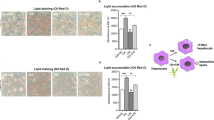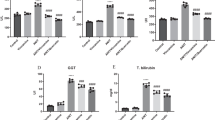Abstract
Melatonin, an indole neurohormone secreted mainly by the pineal gland, has been found to be involved in a variety of liver diseases. However, the underlying mechanism by which melatonin ameliorates cholestatic liver injury is not fully understood. In this study, we investigated the mechanism by which melatonin attenuates cholestatic liver injury via inhibition of the inflammatory response. We measured the levels of serum melatonin in patients with obstructive cholestasis (n = 9), patients with primary biliary cholangitis (PBC) (n = 11), and control patients (n = 7). We performed experiments with C57BL/6 J mice treated with 3,5-diethoxycarbonyl-1,4-dihydrocollidine (DDC) and melatonin to verify the role of melatonin in the mouse model of cholestasis. Primary mouse hepatocytes were used for in vitro studies to study the mechanisms of action of melatonin in cholestasis. The levels of serum melatonin were markedly increased and negatively correlated with serum markers of liver injury in cholestatic patients. As expected, oral administration of melatonin significantly attenuated cholestasis-induced liver inflammation and fibrosis in 0.1% DDC diet-fed mice. Further mechanistic studies in cholestatic mice and primary hepatocytes revealed that melatonin reduced the conjugate BA-stimulated expression of cytokines (e.g. Ccl2, Tnfα, and Il6) through the ERK/Egr1 signalling pathway in these models. The levels of serum melatonin are significantly elevated in cholestatic patients. Melatonin treatment ameliorates cholestatic liver injury by suppressing the inflammatory response in vivo and in vitro. Therefore, melatonin is a promising novel therapeutic strategy for cholestasis.





Similar content being viewed by others
Data availability
The dataset used for the current study is available from the corresponding author on reasonable request.
Abbreviations
- BDL:
-
Bile duct ligation
- ERK:
-
Extracellular signal-regulated kinase
- KO:
-
Knockout
- mRNA:
-
Messenger RNA
- PBC:
-
Primary biliary cholangitis
- PCR:
-
Polymerase chain reaction
- TCA:
-
Taurocholate acid
- TDCA:
-
Taurodeoxycholic acid
- WT:
-
Wild type
- DDC:
-
3,5-Diethoxycarbonyl-1,4-dihydrocollidine
References
Wagner M, Zollner G, Trauner M (2009) New molecular insights into the mechanisms of cholestasis. J Hepatol 51:565–580. https://doi.org/10.1016/j.jhep.2009.05.012
Santiago P, Scheinberg AR, Levy C (2018) Cholestatic liver diseases: new targets, new therapies. Therap Adv Gastroenterol 11:1756284818787400. https://doi.org/10.1177/1756284818787400
Yokoda RT, Carey EJ (2019) Primary biliary cholangitis and primary sclerosing cholangitis. Am J Gastroenterol 114:1593–1605. https://doi.org/10.14309/ajg.0000000000000268
Cai SY, Ge M, Mennone A, Hoque R, Ouyang X, Boyer JL (2020) Inflammasome is activated in the liver of cholestatic patients and aggravates hepatic injury in bile duct–ligated mouse. Cell Mol Gastroenterol Hepatol 9:679–688. https://doi.org/10.1016/j.jcmgh.2019.12.008
Cai SY, Boyer JL (2021) The role of bile acids in cholestatic liver injury. Ann Transl Med 9:737. https://doi.org/10.21037/atm-20-5110
Cipolla-Neto J, Amaral FGD (2018) Melatonin as a hormone: new physiological and clinical insights. Endocr Rev 39:990–1028. https://doi.org/10.1210/er.2018-00084
Tan DX, Manchester LC, Esteban-Zubero E, Zhou Z, Reiter RJ (2015) Melatonin as a potent and inducible endogenous antioxidant: synthesis and metabolism. Molecules 20:18886–18906. https://doi.org/10.3390/molecules201018886
Zhang JJ, Meng X, Li Y, Zhou Y, Xu DP, Li S, Li HB (2017) Effects of melatonin on liver injuries and diseases. Int J Mol Sci 18:673. https://doi.org/10.3390/ijms18040673
Pan Q, Zhang X, Zhang L, Cheng Y, Zhao N, Li F, Zhou X, Chen S, Li J, Xu S, Huang D, Chen Y, Li L, Wang H, Chen W, Cai SY, Boyer JL, Chai J (2018) Solute carrier organic anion transporter family member 3A1 is a bile acid efflux transporter in cholestasis. Gastroenterology 155:1578-1592.e16. https://doi.org/10.1053/j.gastro.2018.07.031
European Association for the Study of the Liver (2017) EASL clinical practice guidelines: the diagnosis and management of patients with primary biliary cholangitis. J Hepatol 67:145–172. https://doi.org/10.1016/j.jhep.2017.03.022
Chai J, Cai SY, Liu X, Lian W, Chen S, Zhang L, Feng X, Cheng Y, He X, He Y, Chen L, Wang R, Wang H, Boyer JL, Chen W (2015) Canalicular membrane MRP2/ABCC2 internalization is determined by Ezrin Thr567 phosphorylation in human obstructive cholestasis. J Hepatol 63:1440–1448. https://doi.org/10.1016/j.jhep.2015.07.016
Chai J, He Y, Cai SY, Jiang Z, Wang H, Li Q, Chen L, Peng Z, He X, Wu X, Xiao T, Wang R, Boyer JL, Chen W (2012) Elevated hepatic multidrug resistance-associated protein 3/ATP-binding cassette subfamily C3 expression in human obstructive cholestasis is mediated through tumor necrosis factor alpha and c-Jun NH2-terminal kinase/stress-activated protein kinase-signaling pathway. Hepatol 55:1485–1494. https://doi.org/10.1002/hep.24801
Cai SY, Gautam S, Nguyen T, Soroka CJ, Rahner C, Boyer JL (2009) ATP8B1 deficiency disrupts the bile canalicular membrane bilayer structure in hepatocytes, but FXR expression and activity are maintained. Gastroenterology 136:1060–1069. https://doi.org/10.1053/j.gastro.2008.10.025
Ostrycharz E, Wasik U, Kempinska-Podhorodecka A, Banales JM, Milkiewicz P, Milkiewicz M (2020) Melatonin protects cholangiocytes from oxidative stress-induced proapoptotic and proinflammatory stimuli via mir-132 and mir-34. Int J Mol Sci 21:9667. https://doi.org/10.3390/ijms21249667
Wu N, Meng F, Zhou T, Han Y, Kennedy L, Venter J, Francis H, DeMorrow S, Onori P, Invernizzi P, Bernuzzi F, Mancinelli R, Gaudio E, Franchitto A, Glaser S, Alpini G (2017) Prolonged darkness reduces liver fibrosis in a mouse model of primary sclerosing cholangitis by miR-200b down-regulation. FASEB J 31:4305–4324. https://doi.org/10.1096/fj.201700097R
Ambade A, Lowe P, Kodys K, Catalano D, Gyongyosi B, Cho Y, Iracheta-Vellve A, Adejumo A, Saha B, Calenda C, Mehta J, Lefebvre E, Vig P, Szabo G (2019) Pharmacological inhibition of CCR2/5 signaling prevents and reverses alcohol induced liver damage, steatosis, and inflammation in mice. Hepatology 69:1105–1121. https://doi.org/10.1002/hep.30249
Cai SY, Ouyang X, Chen Y, Soroka CJ, Wang J, Mennone A, Wang Y, Mehal WZ, Jain D, Boyer JL (2017) Bile acids initiate cholestatic liver injury by triggering a hepatocyte-specific inflammatory response. JCI Insight 2:e90780. https://doi.org/10.1172/jci.insight.90780
Li M, Cai SY, Boyer JL (2017) Mechanisms of bile acid mediated inflammation in the liver. Mol Aspects Med 56:45–53. https://doi.org/10.1172/10.1016/j.mam.2017.06.001
Hisamoto S, Shimoda S, Harada K, Iwasaka S, Onohara S, Chong Y, Nakamura M, Bekki Y, Yoshizumi T, Ikegami T, Maehara Y, He XS, Gershwin ME, Akashi K (2016) Hydrophobic bile acids suppress expression of AE2 in biliary epithelial cells and induce bile duct inflammation in primary biliary cholangitis. J Autoimmun 75:150–160. https://doi.org/10.1016/j.jaut.2016.08.006
Li Y, Yu H, Xu Z, Shi S, Wang D, Shi X, Wang Y, Zeng B, Deng H, Deng X, Zhong X (2019) Melatonin ameliorates ANIT-induced cholestasis by activating Nrf2 through a PI3K/Akt-dependent pathway in rats. Mol Med Rep 19:1185–1193. https://doi.org/10.3892/mmr.2018.9746
Sheen JM, Chen YC, Hsu MH, Tain YL, Huang YH, Tiao MM, Li SW, Huang LT (2016) Melatonin alleviates liver apoptosis in bile duct ligation young rats. Int J Mol Sci 17:1365. https://doi.org/10.3390/ijms17081365
Pose E, Sancho-Bru P, Coll M (2019) 3,5-Diethoxycarbonyl-1,4-dihydrocollidine diet: a rodent model in cholestasis research. Methods Mol Biol 1981:249–257. https://doi.org/10.1007/978-1-4939-9420-5_16
Mziaut H, Henniger G, Ganss K, Hempel S, Wolk S, McChord J, Chowdhury K, Ravassard P, Knoch KP, Krautz C, Weitz J, Grützmann R, Pilarsky C, Solimena M, Kersting S (2020) MiR-132 controls pancreatic beta cell proliferation and survival through Pten/Akt/Foxo3 signaling. Mol Metab 31:150–162. https://doi.org/10.1016/j.molmet.2019.11.012
Zhang Y, Klaassen CD (2010) Effects of feeding bile acids and a bile acid sequestrant on hepatic bile acid composition in mice. J Lipid Res 51:3230–3242. https://doi.org/10.1194/jlr.M007641
Fukumoto Y, Ando M, Yasunaga M, Okuda M, Okita K (1994) Secretin prevents taurocholate-induced intrahepatic cholestasis in the rat. J Hepatol 20:750–754. https://doi.org/10.1016/s0168-8278(05)80145-x
Fukumoto Y, Murakami F, Tateishi A, Itoh Y, Sakaida I, Okita K (2002) Effects of secretin on TCDCA- or TDCA-induced cholestatic liver injury in the rat. Hepatol Res 22:214–222. https://doi.org/10.1016/s1386-6346(01)00141-3
Kim ND, Moon JO, Slitt AL, Copple BL (2006) Early growth response factor-1 is critical for cholestatic liver injury. Toxicol Sci 90:586–595. https://doi.org/10.1093/toxsci/kfj111
Allen K, Jaeschke H, Copple BL (2011) Bile acids induce inflammatory genes in hepatocytes: a novel mechanism of inflammation during obstructive cholestasis. Am J Pathol 178:175–186. https://doi.org/10.1016/j.ajpath.2010.11.026
Allen K, Kim ND, Moon JO, Copple B (2010) Upregulation of early growth response factor-1 by bile acids requires mitogen-activated protein kinase signaling. Toxicol Appl Pharmacol 243:63–67. https://doi.org/10.1016/j.taap.2009.11.013
Acknowledgements
We would like to thank our team members (Cholestatic Liver Diseases Center and Center for Metabolic Associated Fatty Liver Disease, The First Affiliated Hospital to Third Military Medical University, Chongqing, China) for their technical assistance.
Funding
This work was supported by National Natural Science Foundation of China (81922012, 82000545) and Natural Science Foundation of Southwest Hospital (XZ-2019-505-071).
Author information
Authors and Affiliations
Contributions
JC and XZ conceived the experiments; YT, JC and XZ wrote the paper; YT and NZ performed the experiments; YL, YT and QX analysed the data; QX, ZX and YL contributed to reagents/materials/analysis tools; YL and XZ designed the experiments.
Corresponding authors
Ethics declarations
Conflict of interest
The authors disclose no conflicts.
Ethical approval
We recruited patients from the Institute of Hepatobiliary Surgery and Department of Gastroenterology, The First Affiliated Hospital to Third Military Medical University (Chongqing, China). The study protocol was approved by the Institutional Ethics Review Board of The First Affiliated Hospital to Third Military Medical University, Chongqing, China (B-KY2021038). All animal studies and protocols were approved by the Institutional Animal Care and Use Committee of Third Military Medical University (AMUWEC20201580).
Additional information
Publisher's Note
Springer Nature remains neutral with regard to jurisdictional claims in published maps and institutional affiliations.
Rights and permissions
Springer Nature or its licensor (e.g. a society or other partner) holds exclusive rights to this article under a publishing agreement with the author(s) or other rightsholder(s); author self-archiving of the accepted manuscript version of this article is solely governed by the terms of such publishing agreement and applicable law.
About this article
Cite this article
Tan, Y., Zhao, N., Xie, Q. et al. Melatonin attenuates cholestatic liver injury via inhibition of the inflammatory response. Mol Cell Biochem 478, 2527–2537 (2023). https://doi.org/10.1007/s11010-023-04682-7
Received:
Accepted:
Published:
Issue Date:
DOI: https://doi.org/10.1007/s11010-023-04682-7




